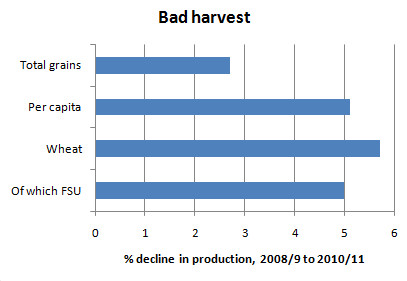Here are some percentage changes in world grain production between 2008/2009 and 2010/2011, according to the USDA estimates:
 USDA
USDAOverall grain production is down — and it’s down substantially more when you take account of a growing world population. Wheat production (this time not per capita) is way down. You might ask why a production shortfall of 5 percent leads to a doubling of prices. Part of the answer is that some kinds of demand are growing faster than population — in particular, China is becoming a growing importer of feed to meet the demand for meat. But the main point is that the demand for grain is highly price-inelastic: it takes big price rises to induce people to consume less, yet collectively that’s what they must do given the shortfall in production. Why is production down? Most of the decline in world wheat production, and about half of the total decline in grain production, has taken place in the former Soviet Union — mainly Russia, Ukraine, and Kazakhstan.
... Update: The USDA has estimates of price elasticities. For the United States, they put the price elasticity of demand for breads and cereals at 0.04 — that is, it would take a 25 percent rise in price to induce a 1 percent fall in consumption.
... Update: The USDA has estimates of price elasticities. For the United States, they put the price elasticity of demand for breads and cereals at 0.04 — that is, it would take a 25 percent rise in price to induce a 1 percent fall in consumption.
No hay comentarios:
Publicar un comentario